Granite comes in a stunning range of colours, from bright white to deep black, with shades of pink, red, green, and even blue in between. But what exactly causes this single type of rock to display such a variety of colours? Whether you’re a geology enthusiast, curious about nature, or just shopping for new granite, you’ll find the science behind granite’s colours fascinating. Each hue tells a story about the minerals that make up the granite and the conditions under which it formed. 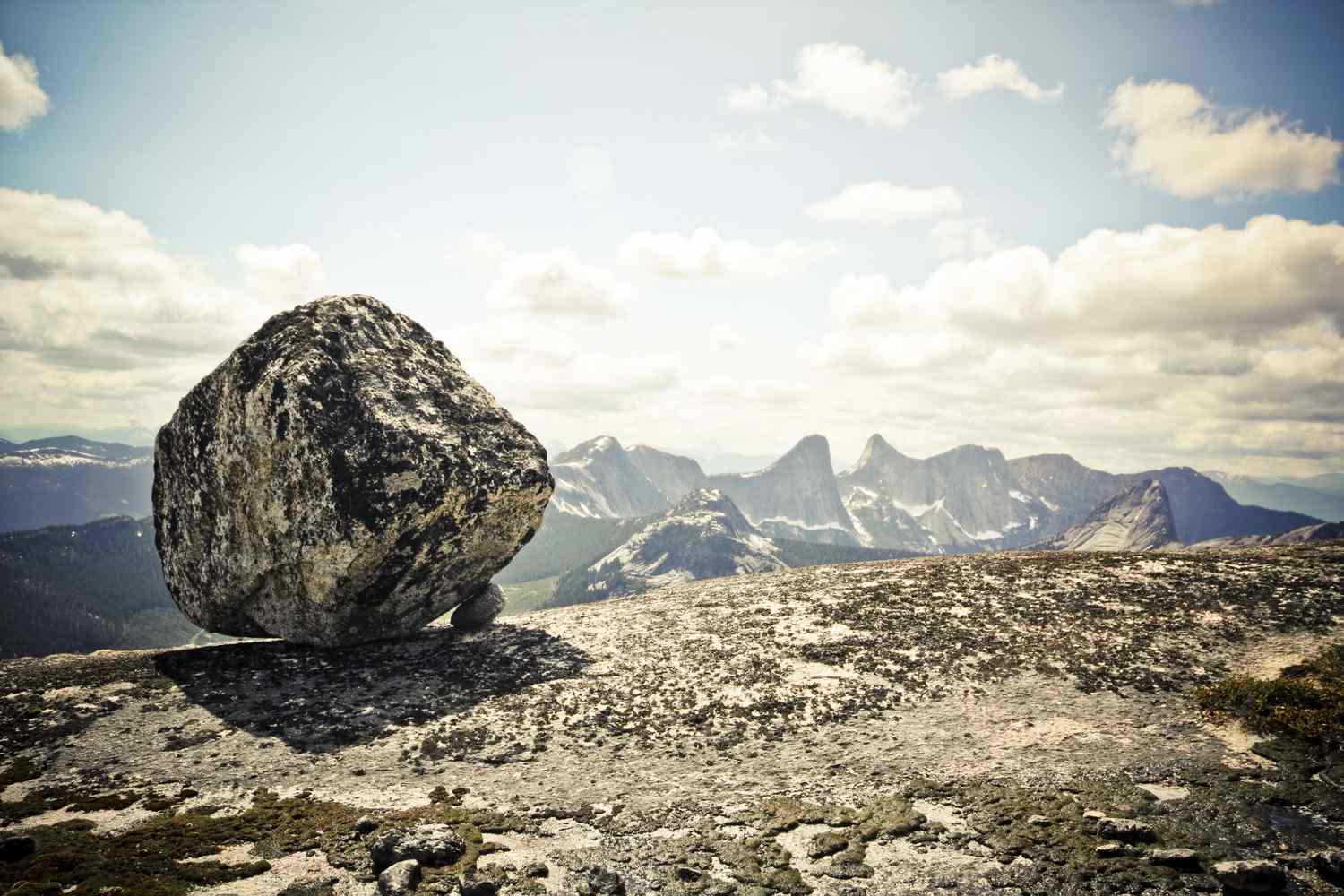
Did you know? Some stones marketed as black ‘granite’ are more likely to be gabbro. For a rock to be considered as granite, it must contain at least 20% quartz.
Let’s explore what makes each type of granite distinct in its look and uncover the factors that give each granite its unique colour, revealing insights into its mineral composition and origin.
What is Granite?
At its core, granite is an intrusive igneous rock that forms when molten lava below the Earth’s surface cools and hardens. This slow process, which takes millions of years, gives granite its unique structure and makes it extremely durable. Quartz, feldspar, and mica are the main minerals that make up granite. Each plays an important role in how the stone looks.Let’s try and understand what an intrusive igneous rock is in simple terms:
Intrusive Igneous Rock: Imagine the Earth’s crust as a giant oven. When molten rock (magma) gets trapped inside the crust, it cools down very slowly. This slow cooling process allows large mineral crystals to form, which is what gives granite its unique texture. These rocks are called “intrusive” because the magma stays inside the Earth’s crust instead of erupting out.
Now, if the molten had erupted through a volcano and cooled quickly, it wouldn’t have had time to form those large crystals. Instead, it would cool into a more uniform, fine-grained rock. These are called “extrusive” rocks because they form on the Earth’s surface.
So, in simple terms, intrusive rocks like granite form deep inside the Earth and cool slowly, which is why they have those big, visible crystals. Extrusive rocks cool quickly on the surface and don’t have the same texture.
Physical Properties of Granite
The physical properties of granite are key to understanding why it’s such a popular and durable material. Here’s a rundown of its main characteristics:
Hardness: Granite is an extremely hard rock, which makes it resistant to scratches and abrasion. It ranks about 6 to 7 on the Mohs hardness scale, which measures the scratch resistance of minerals.
Density: Granite is dense and heavy, which contributes to its durability. The granite’s density typically ranges from 2.63 to 2.75 grams per cubic centimetre (g/cm³).
Porosity: Granite is relatively low in porosity compared to other stones. This means it doesn’t absorb much water or other liquids, which helps prevent staining and damage.
Durability: Granite’s hardness and low porosity make it highly durable and resistant to wear and tear. This makes it suitable for high-traffic areas and outdoor use.
Heat Resistance: Granite can withstand high temperatures without damage. It’s a good choice for kitchen countertops and other surfaces that may experience heat.
Chemical Resistance: Granite is resistant to most acids and chemicals, but strong acidic substances or harsh cleaning agents should still be avoided to maintain its appearance.
ALSO READ | Why Choose Granite: Comparing Hardness, Porosity, Stain Resistance, and Durability
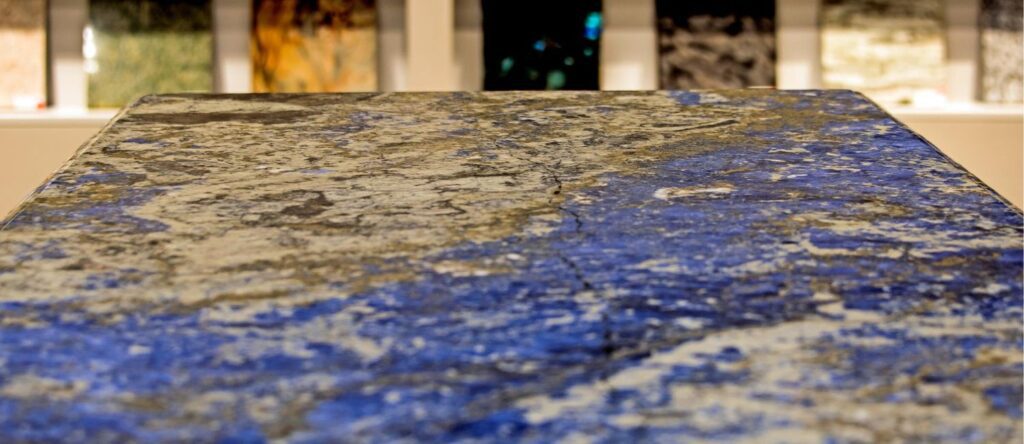
How Granite Colours Are Determined?
Granite is made up of different minerals and rocks, with the main ones being quartz, potassium feldspar, mica, and amphiboles. These minerals give granite its unique colours and patterns.
Quartz: Quartz is a major component of granite, typically making up about 20-60% of the rock. Chemically, quartz is composed of silicon dioxide (SiO₂). It’s responsible for the glassy lustre and durability of granite.
Feldspar: Feldspar is another major component, constituting about 10-65% of granite. There are two main types:
- Potassium Feldspar (KAlSi₃O₈): Gives granite a pink or salmon colour.
- Plagioclase Feldspar (a series of minerals including albite to anorthite): Can contribute to white or gray colours.
Mica: Mica is present in smaller amounts, typically 5-15% of granite. There are two main types of mica:
- Biotite (black or dark brown): Adds darker colours to granite.
- Muscovite (metallic gold or yellow): Can add lighter hues.
Amphibole: This group of minerals can make up a small part of granite, contributing to darker colours like black or dark green. Amphiboles are silicate minerals containing iron and magnesium.
Accessory Minerals: These are present in trace amounts and can include minerals like zircon, apatite, and magnetite. They often influence the specific colour and texture of the granite.
Trace Elements: Various trace elements can be present in very small amounts and contribute to the overall colour and characteristics of the granite. For example, iron can cause red or pink hues, while titanium and manganese can influence colour variations.
The mix of these minerals in granite comes from the original molten rock that cooled to form the granite. Depending on which minerals were present in the molten rock, the granite can take on different colours. For example:
- If there’s a lot of potassium feldspar, the granite might be a salmon pink colour.
- If there’s more quartz and amphibole, the granite could have a black-and-white speckled look, like the kind you often see on countertops.
Next, let’s explore the different colour ranges of granite and what causes these colours.
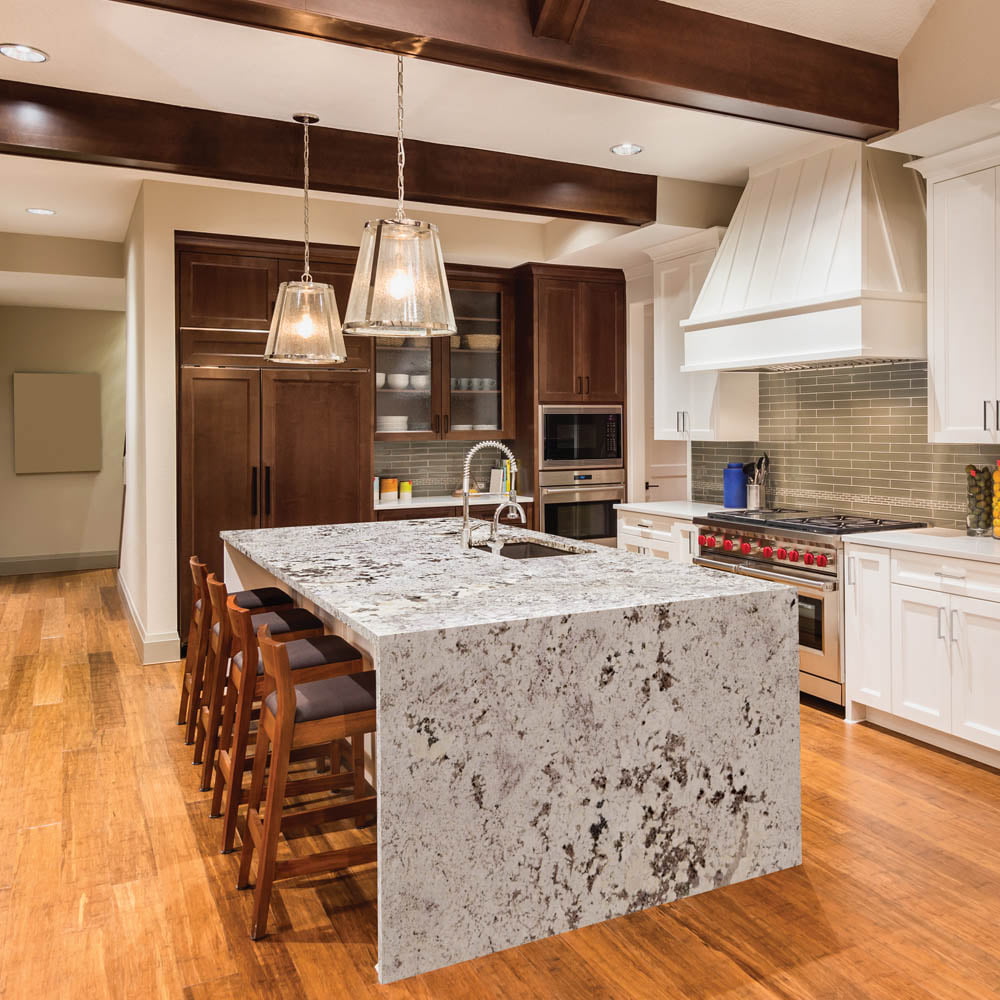
What Gives Granite White Colour?
Granite appears white mainly due to the minerals that make it up. Here’s what contributes to its white colour:
Quartz: This is the primary mineral responsible for the white colour in granite. Quartz is usually milky white or clear, and its presence gives white granite its light appearance.
Feldspar: Another mineral in white granite is feldspar, which can be off-white or light-coloured. It often mixes with quartz to enhance the overall white hue.
Lack of Dark Minerals: White granite typically has minimal dark-coloured minerals like biotite or amphibole, which are more common in darker granites. The absence of these dark minerals helps keep the granite looking light and white.
So, white granite gets its color from a high proportion of quartz and feldspar, combined with fewer dark minerals.
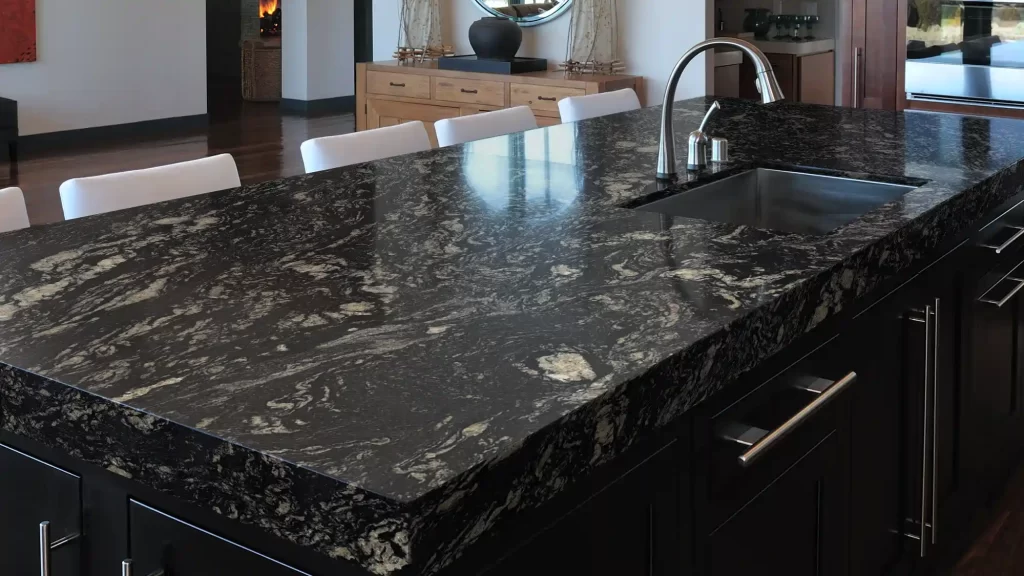
What Makes Black Granite?
Just as white granite gets its colour from specific minerals, black granite’s dark hue comes from different factors:
Dark Minerals: The primary contributors to black granite are minerals like biotite and amphibole. Biotite is a dark, shiny mineral, and amphibole can be black or dark green. Their presence gives the granite its deep, black colour.
Lack of Light-Colored Minerals: Black granite often has minimal quartz and feldspar, which are lighter in colour. The absence of these minerals helps maintain the granite’s dark appearance.
Gabbro Confusion: It’s worth noting that some rocks marketed as black granite are gabbro, which is a similar dark rock but lacks the required quartz content of true granite. Gabbro’s composition includes minerals like pyroxene and plagioclase, contributing to its black look.
What Makes Granite Black & White?
Granite with a black-and-white pattern gets its distinct appearance from a combination of minerals:
Quartz: Quartz is often the main mineral in black and white granite, contributing to the white or light-coloured speckles. Its milky or translucent appearance creates lighter tones in the granite.
Feldspar: Feldspar can appear white, grey, or pink. In black and white granite, feldspar adds to the white and grey specks.
Biotite or Amphibole: These dark minerals give the granite its black or dark speckles. Biotite is a black mica, while amphibole can range from dark green to black.
Pattern Formation: The black and white pattern forms due to the different cooling rates and mineral compositions in the molten rock. As the rock cools, the minerals crystallize at different rates, creating contrasting colours and patterns.
Overall, the combination of these minerals and their distribution during the cooling process results in the striking black-and-white patterns seen in this type of granite.
How Does Granite Get Its Red or Brown Colour?
Granite gets its red or brown colour mainly from potassium feldspar, which ranges from salmon pink to reddish-brown. Iron oxides, such as hematite, also add reddish or rusty hues. The interplay of these minerals with quartz and other elements gives granite its rich red and brown tones.
How Does Granite Get Its Green or Blue Colour?
Granite gets its green or blue colour from specific minerals that are present in the rock:
Green Granite
Olivine: This mineral can give granite a greenish hue. It’s often found in volcanic rocks but can also be present in granite.
Chlorite: Chlorite can also contribute to a green color. It is a group of minerals that often forms in metamorphic rocks.
Amazonite: This is a green variety of feldspar that can add a greenish tint to granite.
Blue Granite
Labradorite: This type of feldspar can appear blue and is often the primary mineral responsible for the blue hues in granite. It has a characteristic play of color, which can include blue and green shades.
Sodalite: This mineral can impart a deep blue color, though it’s more common in some types of granite than others.
How is Pink Granite Formed?
The chemical makeup of the magma, particularly the presence of potassium and the absence of certain minerals, influences the pink colouration. The pink colour mainly comes from the high concentration of potassium feldspar in the magma, a mineral that has a pink to salmon hue. It also contains quartz, which is usually light-coloured, and can have small amounts of biotite or muscovite, which can add darker flecks.
How Does Multi-Colour Granite Get Its Colours?
Multicolor granite gets its vibrant and varied colors from the different minerals present in the rock and how they interact during the formation process. Here’s a simple breakdown:
Mineral Mix: Multicolor granite contains a variety of minerals, each contributing its own color. Common minerals in multicolor granite include:
- Quartz: Usually light-colored, contributing white or gray hues.
- Feldspar: Can be pink, red, or orange, depending on the type (potassium feldspar or plagioclase).
- Biotite and Muscovite: These mica minerals can add black, brown, or gold flecks.
- Amphibole: Can introduce dark green or black tones.
Cooling Process: The way the granite cools and solidifies affects how these minerals crystallize and mix. Rapid cooling might trap minerals in different patterns, while slower cooling allows for more distinct mineral separation and color variation.
Chemical Composition: The specific mix of chemicals in the molten rock influences the colors of the minerals that form. For example, a higher concentration of iron can lead to darker colors, while different types of feldspar can produce various shades of pink or red.
Patterns in granite show how minerals moved around and mixed as the rock cooled and hardened. This interaction makes designs that are often made up of minerals like biotite and hornblende, as well as feldspar and quartz. The way these rocks are arranged makes for a wide range of beautiful patterns that make each granite slab a unique work of art.
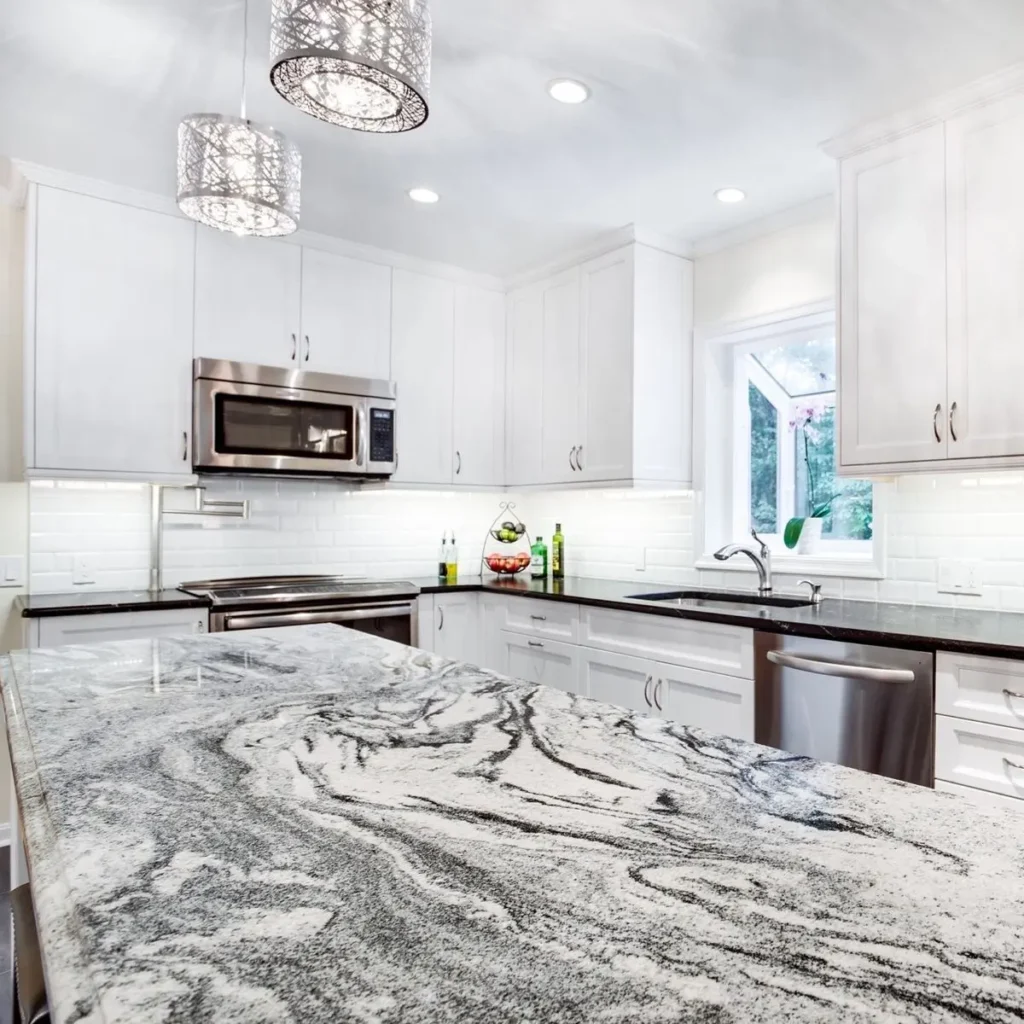
What Causes the Different Patterns in Granite?
Granite gets its patterns from several factors, beyond just its colour. Here’s how these patterns form:
Mineral Distribution: Different minerals in granite, such as quartz, feldspar, and mica, crystallize in various sizes and shapes. The distribution and alignment of these minerals can create patterns like speckles, swirls, or veining.
Cooling Rate: The speed at which molten rock cools affects crystal formation. Slow cooling allows larger crystals to form and settle in patterns, while rapid cooling results in smaller, more evenly distributed crystals. This variation can create unique patterns within the granite.
Chemical Composition: The chemical makeup of the molten rock influences how minerals crystallize. Variations in the concentration of different elements lead to diverse patterns, such as streaks or flecks of contrasting colours.
Inclusions and Impurities: Sometimes, granite contains other materials or minerals (called inclusions) that can affect its pattern. For example, the presence of iron or other minerals can create speckled or marbled effects.
Structural Formation: Natural geological processes, such as the flow of molten rock or pressure changes, can affect the texture and patterns of granite. These processes can result in formations like streaks, bands, or swirls in the rock.
Conclusion
Granite is a rock of many colours and patterns, thanks to the mix of minerals and how it cools. From bright whites and deep blacks to vibrant pinks and calming greens, each granite slab tells a unique story about its formation. The colours and patterns we see are shaped by the minerals present and how they interact during the cooling process.
Whether you’re fascinated by the science behind granite or choosing the perfect slab for your next project, understanding what gives granite its range of colours can help you make an informed decision. At Stone Galleria, we offer a wide variety of granite options to suit every taste and need. Explore our collection to find the ideal granite for your home or project. If you have any questions or need help choosing, don’t hesitate to reach out to us.


 Fact Checked
Fact Checked





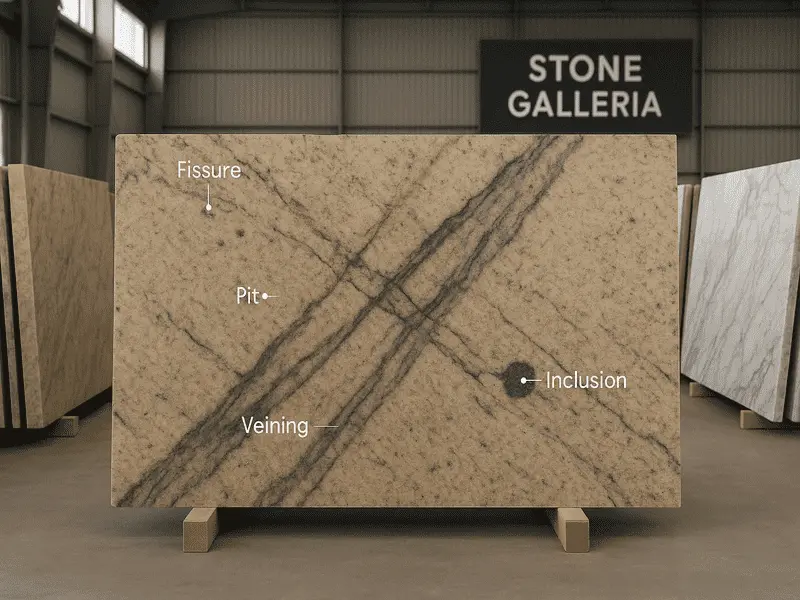
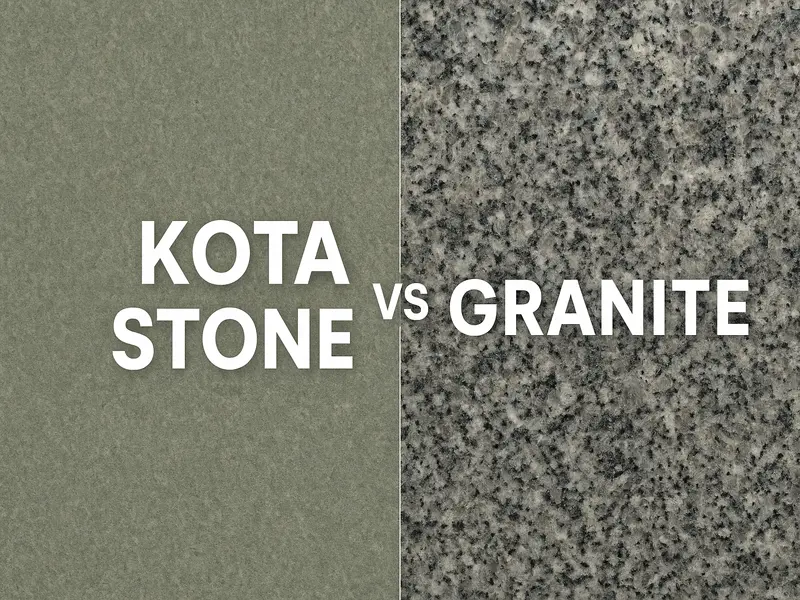



![Latest GST on Granite Slabs & Blocks [2025 Chart + HSN + Price Examples]](https://stonegalleria.in/admin/images/blog/latest-gst-on granite.webp)




